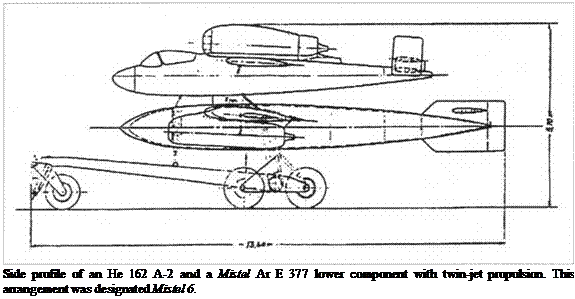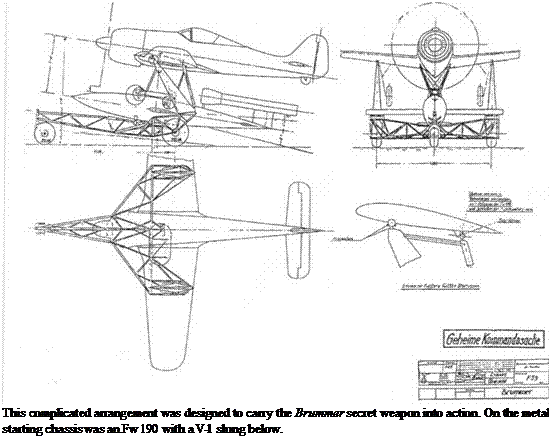Mistel 6 (Ar E 377/He 162 orAr234 C-3)

The two Arado plans presented to the RLM in August 1944 were discussed on 4 and 5 September at Landeshut/Silesia with RLM representatives. An average speed of700 km/hr (435 mph) was proposed, as with the Ar 234 B-2.The Mistel would have an additional powerplant of two ‘cast off’ turbines which had to provide between 300 and 500 kg standing thrust. They would be limited in size to 0.5 metres diameter and 2.5 metres in length and easy to maintain. Arado’s idea for a plastic fuselage was rejected by the RLM because the material had not

been perfected: the lower aircraft would be all-wood. The wings were to be shoulder-mounted and tapered and would serve as auxiliary fuel tanks for the parent aircraft as suggested by Dr Hiitter. The 20-tonne Mistel would take off using a Rheinmetall-Borsig chassis which could remain attached to the lower aircraft during flight to enable landings without fuel and payload. The power – plant was an Ar 234 C-3 using four 1,000 kg-thrust rockets on the take-off chassis. The Ar E 377 itself could be piloted if necessary by means of fighter pilot controls once the upper machine had detached. A 2-tonne explosive charge in the nose was sufficient to sink a 15,000-ton ship. For ground targets a thin – cased container with up to 500 kg flammable liquid was planned.
On 30 November 1944 the design division completed detailed drawings of the two versions in which the previous SC 1800 was replaced by a more destructive 2-tonne bomb. On 7 December 1944 the Arado team provided the completed specifications for the new Mistel as follows:
(i) Ar 234 C-3 with Ar E 377 or Ar E 377a on 20-tonne take-off chassis;
(ii) He 162 with Ar E 377a on 20-tonne take-off chassis.
The lower unit with explosive payload would be steered in flight on a straight course to the target by means of a gunsight in the Ar 234 C-3. An He 162 could

have been used in place of the jet bomber. Probably the only difference in construction from the Ar 234 would have been in the use of explosive bolts to hold the Volksjager and Arado body together, since the Ar 234 spring bolt was not practical for the lighter He 162 to guarantee the release. If used with the He 162, the lower unit would have had two BMW 003 A-l turbines installed below the wings to supplement the engine power of the fighter, and a reserve of 4.5 tonnes of fuel.
This idea was abandoned by OKL on the grounds that there were insufficient He 162 A-2s to equip the envisaged JG 1, and the Riistungsstab would have had to free the necessary capacity to build the Ar E 377. In the few weeks before the final collapse, this Mistel would not have been possible no matter which system was chosen.










